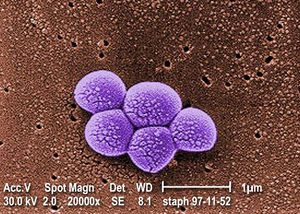Microbes in Agricultural Soil: Difference between revisions
No edit summary |
|||
| Line 35: | Line 35: | ||
==Introduction== | ==Introduction== | ||
</b> Many agroecologists have said that in order to feed an ecosystem you need to feed the soil. | </b> Many agroecologists have said that in order to feed an ecosystem you need to feed the soil.Microbes can be found across a variety of environments, including in the soils. In fact, it’s been said that there are more microbes in a teaspoon of soil than there are people on Earth [1]. These microbes serve a multitude of ecosystem functions. Soil microbes are beneficial in determining the nutrient content of food, and this is often done through the transformation of degradable organic compounds to an inorganic, readily available form for crops [2]. Some examples of these microbes include Bacillus, Azotobacter, Microbacterium, Erwinia, Beijerinckia, Enterobacter, Flavobacterium, Pseudomonas, and Rhizobium bacteria, which are all examples of phosphate solubilizers [2]. A phosphate solubilizer turns phosphate, a crucial nutrient, from an inaccessible form to one that is easily taken in and stored by plants. Some other examples include cyanobacteria (Anabaena, Nostoc, Calothrix), Azotobacter, Azospirillum, and Gluconacetobacter, which are nitrogen-fixing endophytes, a type of symbiote [2]. Similar to phosphate solubilizers, nitrogen-fixers convert nitrogen to a form more easily accessible to plants. Many farmers have even turned to the application of microbes to promote and maintain soil health [2]. In addition to microorganisms, earthworms also play a role in soil health. Both microorganisms and earthworms leave castings, the end product of digestion, and residuals that serve to increase plant nutrients [6]. When compared to soil devoid of these, soil that had been shaped by microorganism and earthworm activity showed a significant increase in nutrient levels [6]. The presence and activity of such organisms is crucial not just for plant health but also human and animal health. | ||
The abundance and diversity of species as well as their activity vary drastically depending on the soil environment. The optimal environment for soil organisms is that of a natural and healthy soil, in which the biomass of microbes can amount to 4 to 5 tonnes per hectare [6]. However, soil health and fertility is declining in places as a result of increasing fertilizer use, tillage, and crop protectants [6]. As a result of the soil disruption, populations of soil organisms are subject to decline. Many farmers have begun utilizing sustainable farming techniques that limit fertilizer and soil disruption as well as actively introducing healthy microbes to the soil. | |||
<br> | <br> | ||
<br> | <br> | ||
Revision as of 23:52, 13 April 2024
Section


By [Author Name]
At right is a sample image insertion. It works for any image uploaded anywhere to MicrobeWiki.
The insertion code consists of:
Double brackets: [[
Filename: PHIL_1181_lores.jpg
Thumbnail status: |thumb|
Pixel size: |300px|
Placement on page: |right|
Legend/credit: Magnified 20,000X, this colorized scanning electron micrograph (SEM) depicts a grouping of methicillin resistant Staphylococcus aureus (MRSA) bacteria. Photo credit: CDC. Every image requires a link to the source.
Closed double brackets: ]]
Other examples:
Bold
Italic
Subscript: H2O
Superscript: Fe3+
Sample citations: [1]
A citation code consists of a hyperlinked reference within "ref" begin and end codes.
To repeat the citation for other statements, the reference needs to have a names: "<ref name=aa>"
The repeated citation works like this, with a forward slash.[1]
Introduction
Many agroecologists have said that in order to feed an ecosystem you need to feed the soil.Microbes can be found across a variety of environments, including in the soils. In fact, it’s been said that there are more microbes in a teaspoon of soil than there are people on Earth [1]. These microbes serve a multitude of ecosystem functions. Soil microbes are beneficial in determining the nutrient content of food, and this is often done through the transformation of degradable organic compounds to an inorganic, readily available form for crops [2]. Some examples of these microbes include Bacillus, Azotobacter, Microbacterium, Erwinia, Beijerinckia, Enterobacter, Flavobacterium, Pseudomonas, and Rhizobium bacteria, which are all examples of phosphate solubilizers [2]. A phosphate solubilizer turns phosphate, a crucial nutrient, from an inaccessible form to one that is easily taken in and stored by plants. Some other examples include cyanobacteria (Anabaena, Nostoc, Calothrix), Azotobacter, Azospirillum, and Gluconacetobacter, which are nitrogen-fixing endophytes, a type of symbiote [2]. Similar to phosphate solubilizers, nitrogen-fixers convert nitrogen to a form more easily accessible to plants. Many farmers have even turned to the application of microbes to promote and maintain soil health [2]. In addition to microorganisms, earthworms also play a role in soil health. Both microorganisms and earthworms leave castings, the end product of digestion, and residuals that serve to increase plant nutrients [6]. When compared to soil devoid of these, soil that had been shaped by microorganism and earthworm activity showed a significant increase in nutrient levels [6]. The presence and activity of such organisms is crucial not just for plant health but also human and animal health.
The abundance and diversity of species as well as their activity vary drastically depending on the soil environment. The optimal environment for soil organisms is that of a natural and healthy soil, in which the biomass of microbes can amount to 4 to 5 tonnes per hectare [6]. However, soil health and fertility is declining in places as a result of increasing fertilizer use, tillage, and crop protectants [6]. As a result of the soil disruption, populations of soil organisms are subject to decline. Many farmers have begun utilizing sustainable farming techniques that limit fertilizer and soil disruption as well as actively introducing healthy microbes to the soil.
Every point of information REQUIRES CITATION using the citation tool shown above.
Section 2
Include some current research, with at least one figure showing data.
Section 3
Include some current research, with at least one figure showing data.
Section 4
Conclusion
References
- ↑ 1.0 1.1 Hodgkin, J. and Partridge, F.A. "Caenorhabditis elegans meets microsporidia: the nematode killers from Paris." 2008. PLoS Biology 6:2634-2637.
- ↑ Bartlett et al.: Oncolytic viruses as therapeutic cancer vaccines. Molecular Cancer 2013 12:103.
- ↑ Hoorman, J and Islam, R. "Understanding Soil Microbes and Nutrient Recycling." 2010. Agriculture and Natural Resources.
Authored for BIOL 238 Microbiology, taught by Joan Slonczewski,at Kenyon College,2024
